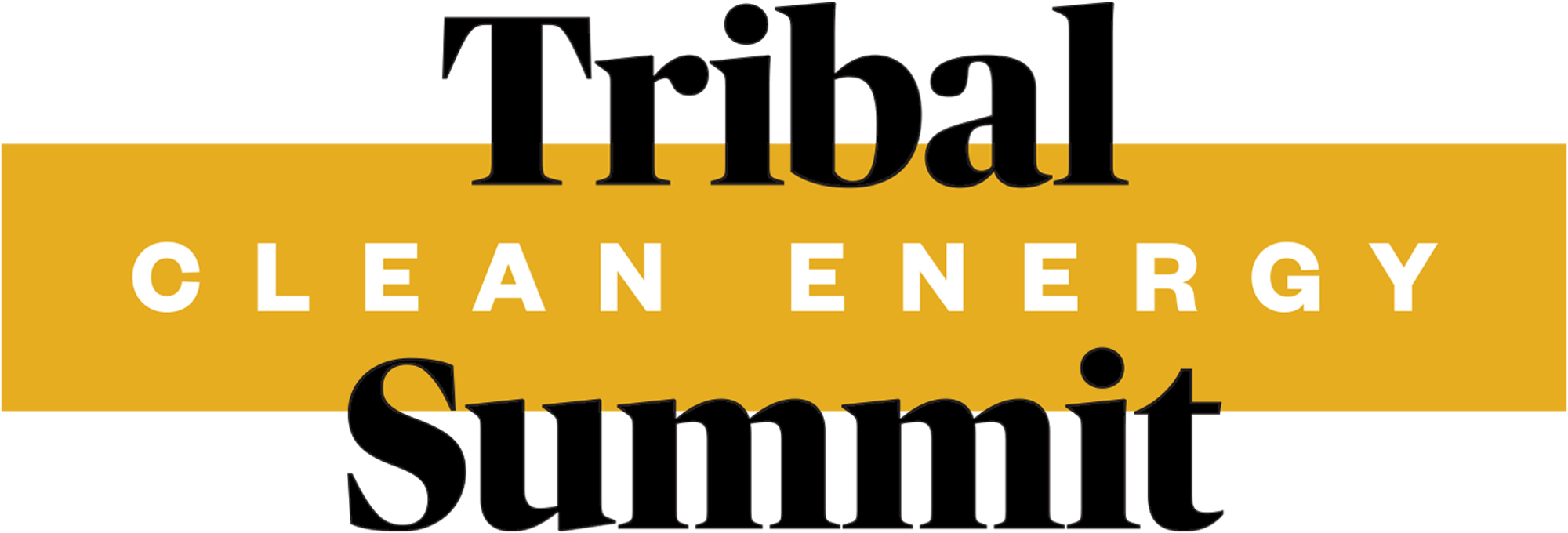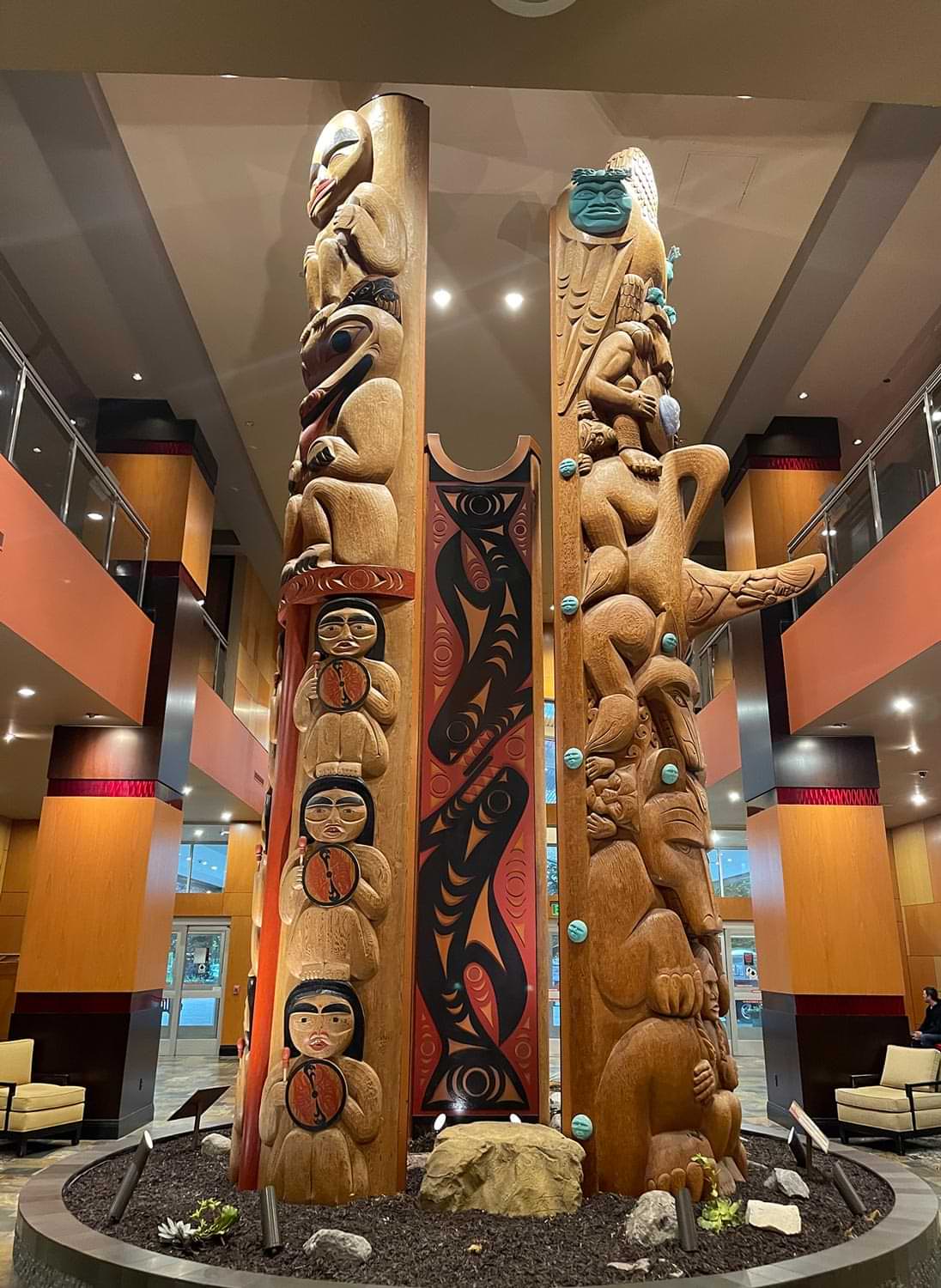

Tribal Clean Energy Summit

received a scholarship from The Affiliated Tribes of Northwest Indians (ATNI) to attend their Clean Energy Summit at the Tulalip Resort and Casino. A sculpture of a black dugout canoe with red trim rests on top of a trickling fountain. Inside the gently lit hotel, red, black, and white colors press against the walls. Coast Salish artwork serves as the centerpiece of the interior. In the hallways, curvilinear designs flow along the carpet with interconnected shapes and lines, creating swimming orcas and salmon. The work extends to light fixtures, room doors, and wall hangings, embodying the cultural values and history of the Tulalip Tribes.
The summit was abundant with people, information, and an eagerness to learn about low-carbon energy and new Federal programs like the $1 Trillion Bipartisan Infrastructure Law and the $300+ Billion Inflation Reduction Act. Five keynote speakers graced the stage from June 13-15. The summit also hosted three workshops and three general assembly panels—six concurrent sessions such as Energy Planning & Development, Off-shore Wind Development, and Creative Funding Solutions. Five other sessions were conducted pertaining to Workforce Development, Emerging Clean Energy Technologies, and Project Siting.
Traditional songs and blessings, accompanied with words of wisdom, sent the convening on its way. Tribal representatives, Federal and State program staff, environmentalists, entrepreneurs, scientists, and academics gathered behind the lofty heights and firm chairs of conference rooms. When U.S. policy and funding programs for Tribal renewable energy were presented, a familiar undercurrent of tension arose. Frustration from some Elders surfaced in the face of trying to solve colonial-caused problems with colonial systems compounded with the ongoing struggle for Tribal sovereignty to be recognized.
The mood softened when Wahleah Johns (Diné), Director U.S. Department of Energy Office of Indian Energy Policy and Programs, began to speak and mentioned the community that she comes from—Najvo Black Mesa, whose resources such as coal and water were exploited to develop large cities around them. Yet, the extraction of these resources did not benefit them at all. Her community is still riddled with homes devoid of electricity and running water. Her family hauls water on a daily basis.
Key Takeaways from Director Wahleah Johns Keynote Address
Technical Analysis: Addresses a specific project need by creating a tangible product or deliverable for the progress of a project. Generally, this involves analysis and modeling, expert review, transmission and/or utility assessment, market access, and energy efficiency reviews.
Financial Analysis: Intended for decision makers in the early stages of energy development and includes economic or market analysis. Some aspects involved are modeling for payback periods, net present value, and levelized energy cost.
Strategic Energy Planning: May include virtual or in-person workshops facilitated by Tribal energy expert(s) to assist Tribal leaders, Elders, and staff in developing an energy plan, and an initial resource assessment, energy options analyses, and development of a viable project roadmap may be provided.
Wahleah’s steadfast communication style piqued the interest of the conference attendees, like when she questioned how many in the audience had a Strategic Energy Plan. Despite the room seating approximately 400 people, less than a dozen hands shot up.
Keynote speaker Pilar Thomas, a partner at Quarles & Brady, introduced herself. “I’m a member of the Pascua Yaqui Tribe, and I’m from Tucson, Arizona. I usually make a joke about the weather or the sun, but that seems really inappropriate given where we are. I mean, do you folks even know what the sun is?” In President Obama’s first term, she served as the Deputy Solicitor of Indian Affairs for the U.S. Department of the Interior. With a broad smile complementing her curly hair, she lightly roasted the Bureau of Indian Affairs. The room erupted with laughter as she said she should have checked first to see if anyone from the BIA was there.
She reiterated the importance of a plan. “Without a plan, energy development becomes ad hoc, tied to specific Tribal administrations, chasing any grant program – whether the grant program is the right way to achieve our goals or not. A plan identifies the policies and programs, the community’s objectives, and maybe even the Tribal laws that will support our goals.”
Pilar remarked. “There has been a lot of ink spilled about how the federal government and Federal law frustrates our efforts, or how States and utilities are ineffective partners, or the market conditions we confront…reasons why we can’t do clean energy projects. And, this ink is not wrong. Yet, very little ink has been used to discuss how we can do it. How we can make energy more affordable for our Tribal members, participate in energy markets, and create more energy resilient reservation and Tribal communities…”
She continued further: “The road to energy sovereignty is paved with acts of Tribal sovereignty. These are sovereign actions we can control. Sovereign actions that promote our goals, our values, and are hopefully grounded in the needs of our communities.”
Highlights from Pilar Thomas Keynote Address Regarding Overcoming Challenges
Federal oversight, regulation, and approvals—adopt HEARTH Act leasing regulations, create a TEDO, obtain TAS status for permitting, and support a change in Federal law to affirm Tribal jurisdiction.
Utility recalcitrance in distributed energy projects—enact a utility regulatory code and mandate the adoption of the required programs, negotiate franchise agreements with your utility, and create your Tribal utility.
State laws and regulations that do not permit the adoption of the Tribe’s clean energy goals and policies—lobby the State legislature to change the State’s energy laws and participate in State regulatory actions to achieve Tribal parity.
Market opportunities are elusive—(1) create our own markets: partner with other Tribes, sell to ourselves, and sell to the Feds; (2) expand our participation in the energy ecosystem—manufacturing, developer, investor, construction; (3) buy, build, and own transmission infrastructure.
Highlights from Sam Schimmel Keynote Address
Keynote speaker Sam Schimmel (Siberian Yupik & Kenaitze) said, “The greatest threat we face today is climate change…it’s one without a clear solution.” I had the opportunity to interview Sam during a sponsored dinner arranged for the attendees. The room was filled with continuous chatter and high-pitched sounds of glass and cutlery lightly hitting against each other. His long black hair was pulled tightly behind his head and he sat across me in an exquisite spotted seal fur vest, speaking with an acute yet gentle cadence. “… we’ve faced governments and we’ve won. We’ve faced disease and we’ve won. Climate change is our biggest threat because it threatens the ability and the tools that we use to practice our culture. It threatens our subsistence in a way that it hasn’t been threatened before. Before we’ve been banned from hunting. We’ve been told we’re not allowed to hunt, but the animals were still there. What climate change is doing is it’s making it so that those animals are no longer there. And the State’s telling us we can’t hunt and we can’t fish. I think it was a wonderful statement from Barrow, from Utqiaġvik, that hunger knows no laws, but you cannot hunt and fish if there are no fish or animals to catch.” Sam pointed out that we are witnessing this with the catastrophic declines in salmon returns in the Yukon River.
In changes and hardship, there’s also opportunity. And that’s what we’re seeing right now with regards to clean energy.
Inflation Reduction Act Opportunities For Tribal Governments and Indigenous Communities
Programs include:
Tribal Climate Resilience: $235 million
Tribal Electrification Program: $150 million
Tribal Energy Loan Guarantee Program: $75 million
Greenhouse Gas Reduction Fund: $7 billion
Clean Heavy Duty Vehicles: $1 billion
Energy Infrastructure Reinvestment Financing: $5 billion
Assistance for Rural Electric Cooperatives: $9.7 billion
Investing in Coastal Communities and Climate Resilience: $2.6 billion
Opportunities
Kevin Blaser of Migizi Economic Development Company mentioned that renewable energy and its sales have more economic potential than Tribal gaming. This comment certainly generated surprise and intrigue from the summit attendees. Panelists presenting on Tribal Energy Sovereignty emphasized the benefits and opportunities of Tribes working together and how collaborating to facilitate and store energy generation and collectively entering the marketplace can be more impactful. This theme of collaboration would arise numerous times throughout the summit beyond the goal of commerce.
Besides the trade potential of supplying energy to large corporations with ESG interests, an important aspect of this endeavor would include working with power utility companies and municipalities, tax credits, job creation, and providing lower costing energy for one’s community. Extensive Federal funds are also available through the 1-Trillion-dollar Bipartisan Infrastructure Law, the $300+ Billion Inflation Reduction Act (IRA), and the Justice40 Initiative.
In this statement, the White House explains the Justice40 Initiative “For the first time in our nation’s history, the Federal Government has made it a goal that 40 percent of the overall benefits of certain Federal investments flow to disadvantaged communities that are marginalized, underserved, and overburdened by pollution.” However, the following question arises: If the Initiative was created to benefit underserved and marginalized communities, shouldn’t the number be 60 percent at the very least? Regardless, there are funds to help support Tribes.
The Bipartisan Infrastructure Law also includes new programs for Tribal Nations. The funding opportunities from a Fact Sheet by the U.S. Department of Transportation, shared by Kieren Daley Laursen (Chickasaw Tribe), Affiliated Tribes of Northwest Indians, are summarized below.
Some of the funding opportunities that were in the law include:
$300 million for a new Rural Surface Transportation grant program that will provide competitive grants to eligible entities to improve and expand the surface transportation infrastructure in rural areas, including on Tribal land.
$1 billion for a new competitive Safe Streets for All program to provide funding directly to and exclusively for local and Tribal governments to support their efforts to advance “vision zero” plans and other complete street improvements to reduce crashes and fatalities, especially for cyclists and pedestrians.
$1 billion for a new MEGA Project Program, which will support multi-modal and multi-jurisdictional projects of national or regional significance. Tribal communities are eligible to apply for funding to complete large critical projects that would otherwise be unachievable without assistance.
$7.5 billion: The law intends to invest $7.5 billion over five years to build out a national network of Electric Vehicle (E.V.) chargers.
Challenges and Concerns
“From a policy perspective, it is a very complex time to figure out everything that is just being released,” Brett Isaac (Diné), Executive Chairman of Navajo Power, stated during the panel discussion Maximizing Benefits from Energy Development in Indian Country with the Inflation Reduction Act. He added that the development is being “Held up by the regulatory pathway while at the same time, these projects need to be deployed rapidly.” Speaking in a calm yet determined tone, he further explained that there has never been a shift in the energy sector like this, perhaps since the invention of the light bulb. Everything is moving so fast; getting ahead of that and planning is critical. “I could show you how to go put solar panels on this building, that’s the easy part. The hard part is stacking the capital with enough forethought to explain it to your leadership.”

photo by ilegvak
Besides the issues of understanding mass amounts of complex policy at a rapid rate, funding programs, developing science and technologies, and planning and implementing energy projects while creating Tribal laws to manage all of this, there are also significant concerns regarding the impact of “clean energy” on the environment, along with our human and non-human relatives. It was pointed out that most of the minerals extracted for clean energy technologies are obtained from forced enslaved or child mining labor.
“One of the things that’s really important, especially around any type of development. Clean energy or otherwise, is ensuring that Tribal values and Tribes are able to maintain, one control of it and two our values are furthered by the projects… it’s fine to make money, but money has to also come back to the Tribe.” Sam Schimmel remarked.
Throughout the summit, apprehension about mines continued to resurface, not only because of the recent detection of large lithium deposits on Tribal lands but the long history of colonialism stealing Indigenous resources, poisoning our communities, and destroying our traditional values; all in the name of progress. There were also concerns about how installing and operating renewable technologies can affect animals.
Another theme recurring throughout the summit was undertaking caution to not repeat past mistakes while simultaneously dealing with the speed at which everything is happening and the lack of space for Tribal leadership and partnership when it comes to policy making and development. “How do we heal from the energy impacts from the past to move forward?” Brett Isaac remarked, posing a great question that is not being asked during discourses concerning the climate crisis despite the necessity to answer such a question.
The values of collaboration, sovereignty, being in good relation with the Earth and all our relatives, uplifting our communities, protecting our food systems and ways of life, making decisions with future generations in mind, and passing on culture and healing were all mentioned at the summit. There is a need to host another conference discussing how these traditional values are specifically upheld and shape the development of Tribal renewable energy projects.
Tribal Low-carbon Energy in Action
Jesse Leighton (Nez Perce) of Nimiipuu Energy could not attend the second day of the session. However, members of the staff discussed their project. Clyde Abrahamson of Spokane Indian Housing Authority Solar Project, Sean Lawrence (Lummi) of Lummi Indian Business Council, and Ray Wiseman with Yakama Power were also panel members on this session.
A common thread across the projects was the notion of being led by innovative people who were not discouraged to try new things and possibly “fail” at them. They also seemed to have a deep understanding of the programs, a willingness to learn, and an adherence to the conviction that the project benefits their Tribe and the broader global community. It seemed crucial to hold the ability to communicate a vision through all levels of Tribal government, from staff and citizens to the Tribal Council, and have people on board with the plan.
Sean Lawrence stated, “Our projects were successful because we have a multifaceted team to bring projects to fruition.” When I asked him what advice he would give a Tribe looking to start a renewable energy project, Sean replied. “Start with engaging your community to identify their wants and needs while also providing how the clean energy project can further the community development goals.”
During the Q&A, an attendee asked the panelists if they were currently engaged in working on E.V. projects. The answers ranged from theorizing due to socio-economics that it would be a while before they saw E.V.s in their community to a Tribal government already having some in its fleet. This guided the discourse toward charging stations and how a Tribe’s proximity to highways, prominent places of employment, or shopping centers all played a role in development along with Federal and State mandates, which also presented potential markets. This session emphasized sharing experiences and collaboratively discussing ideas, challenges, and opportunities. An important theme echoed throughout the summit.
Closing Thoughts
It’s time that we move forward and we look for partnerships. Partnerships on our terms, not on somebody else’s, but partnerships that benefit our peoples.
During a session, an attendee posited that there was no good solution to energy. A panelist responded that electric power has always been extractive. For example, coal has been used for around 150 years. However, using renewable energy with low greenhouse gas and carbon emissions will majorly help with tackling climate change. This is a crucial point to keep in mind. As we strive to lower emissions as quickly as possible, we must simultaneously reimagine and decolonize power structures to avoid recreating the problem that led us here in the first place.
Chas Jones, Climate Resilience Program Director for Affiliated Tribes of Northwest Indians who led the planning for the summit, stated. “I do know that land acquisition costs are an allowed expense for Tribal clean energy projects in many of the available funding programs.” This is an excellent opportunity for Alaska Tribes who do not own any or much land due to federal policy, including statehood and ANCSA.
Regarding the seed of the Summit, Chas explained that when the idea came about, he had not witnessed any grant funding for Tribes to convene on low-carbon energy development. “…there was a growing list of potential partners that were approaching me about the concept of ATNI convening such a meeting. I also heard that many Tribal folks were interested in the topic, but wanted more info. Thus, I decided to try to figure out a way to fund the planning of a Tribal Clean Energy Summit through sponsorships and registration fees. And apparently, the resulting event was a wild success and our Tribes in the Pacific Northwest should be proud of what we came together to create.”
During the compacted three days, the conference’s atmosphere was highly supportive, with some mentioning it was a healing experience for them.
“…one of the traditional values that’s core to Sivuqaq, to Gambell, which is working together. When you hunt small animals, you hunt ducks. You hunt fish, you hunt moose, even bears. One person can’t catch that animal when you want to hunt something as large as a bowhead whale; all of a sudden you need to work together. You need to have a team. You need to have a village. You need to work together and cooperate and collaborate in order to make it so that you can feed your village… if you don’t, then simply you don’t eat.” Sam Schimmel (Siberian Yupik & Kenaitze) said in an interview.
He continued further: “You can’t go out and hunt that whale if you don’t truly trust who’s sitting next to you. And so, we need to bring that mentality to our projects that we’re doing now. For a lot of Tribes, we don’t like working with people because we’ve been hurt in the past. It’s time that we move forward and we look for partnerships. Partnerships on our terms, not on somebody else’s, but partnerships that benefit our peoples. Because pretty soon, somebody else might move forward and our Tribes won’t have the say that we have today.”